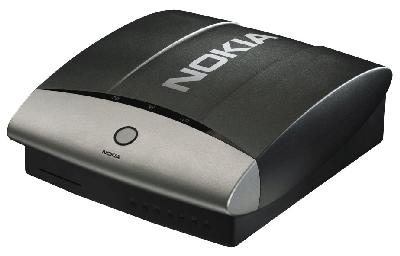Article: Device profile: Nokia Media Terminal
Oct 19, 2000 — by Rick Lehrbaum — from the LinuxDevices Archive — 20 viewsProduct overview
Nokia describes its Media Terminal as a powerful “infotainment center” for the home, which allows consumers to gain the benefits of both Internet access and digital broadcasting. The product leans heavily on open technologies including Linux, Mozilla, and HTML, and is based on an internal “x86” PC-like embedded computer architecture. The product's goal is to make it easy for consumers to access the rich entertainment offerings of the Internet using any convenient display device — including either a TV set or a computer monitor.
The Media Terminal will be the first in a family of products Nokia is targeting at what it calls “the Connected Home”. In addition to its use for web surfing or receiving digital broadcasts, the device will support a variety of interactive digital services such as home shopping and banking. Another important feature is its capability to pause and replay live broadcasts, or split the screen between TV and the Internet. It will also allow its users to watch or record digital TV using its internal high capacity hard disk, listen to Internet radio, play 3D network games, order video-on-demand movies, send and receive email with attachments, listen to and store MP3 files, and access external devices such as printers and digital cameras.

Technical specifics
The Media Terminal's software architecture consists primarily of Linux, the Xfree86 windowing system, and the Mozilla web browser (enhanced for PAL and NTSC display). Rickard Nelger, Head of Media Terminal Product Management of Nokia Home Communications, explains that the development team opted for a full Mozilla-based implementation rather than trying to use a small-footprint embedded browser, because they wanted to be sure to gain maximum benefit from up-to-the-minute browser features and plug-ins. “The small lightweight browsers leave too much unsupported, and tend not to keep up,” says Nelger.
On the hardware side, the Media Terminal is architecturally equivalent to a desktop PC. Its CPU is a 366 MHz Intel Celeron processor, and it uses the popular Intel 810 core logic chipset. Internal memory is at least 32MB RAM, plus a 1MB flash disk that ensures the ability to get online regardless of the state of the internal hard disk. The flash disk serves as a fail-safe mechanism, to avoid a totally incapacitated system in the event of a non-functional or corrupt hard disk image.
I/O interfaces include:
- Digital satellite or cable TV input
- RJ11 telephone or RJ45 Ethernet connector (depends on model)
- S-Video and RJB outputs
- IR interface to external game controllers
- Two USB ports
- Two IEEE-1394 ports
- PCMCIA slot for wireless LAN interface
- Smart card reader interface
Open source connection
According to Nelger, “To be successful in the fast-moving Internet environment, we need to aim for an open Internet community with a multitude of players. Nokia takes a strong part in this community by adopting an active open source strategy. We want as many players as possible to join us and bring the industry forward: consumers, application developers, and hardware manufacturers alike.” Accordingly, the company plans to make certain source code available in order to maximize the freedom to create applications for the Media Terminal. “This way, Nokia gives developers in the open source community a toolkit to reach a substantially wider audience and application space than before,” says Nelger.
In an effort to develop a standardized low-level DVB API for the Linux-based Media Terminal, Nokia has formed an alliance with Convergence Integrated Media GmbH. The DVB API is going to be made publicly available on the LinuxTV.org website.
It might seem that the use of Linux would have been an obvious and easy choice for Nokia, given the company's proximity to the birthplace of Linux and its creator, Linus Torvalds. “Not really,” says Nelger. “We actually had to overcome quite some resistance within Nokia to using Linux and Mozilla in a consumer product such as this.” That issue, however, is now history!
When can I get one?
Nokia's Media Terminal will become available during the second quarter of 2001.
This article was originally published on LinuxDevices.com and has been donated to the open source community by QuinStreet Inc. Please visit LinuxToday.com for up-to-date news and articles about Linux and open source.